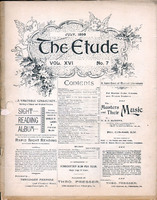ARTHUR E HEACOX.
A question often asked is “What do you do in ear-training?” We sing more or less throughout the course, and use the piano as little as possible. Pupils are urged to join a class in choral singing immediately, if they have not already had good drill in sight-singing by the Movable Do, or the Tonic Sol-fa System. Much stress is laid upon the value of being able to hear mentally any succession of tones when presented to the eye, and also to write or name readily any such succession when played or sung. This ability to ”hear with the eye, and see with the ear” must form a part of the musician’s equipment. Drill in correct notation forms incidentally a valuable part of the work, since the student is expected to write a great variety of exercises, rhythmic, melodic, and harmonic, as fast as he learns to hear them.
In this way eye and ear are educated simultaneously. The good effects of the work reach out into every other branch of music study. There is danger that the piano student will become so engrossed in the study of the instrument—learning how to play—that his ability to hear will not receive proper development.
Some one has said that the average piano student “sees a note, sees a key, strikes it, and, last of all, hears.” With equal truth it may be said that the average student of harmony takes a given exercise, takes a given set of rules, applies them as best he can, and, last of all, hears, if he hears at all, only by playing the result at the piano. The case of the harmony student is more lamentable than that of the pianist, for while the latter may be able to acquire a technic of considerable value, the former is likely to remain rule-bound and never outgrow the mere machinery—the externals—of harmony and counterpoint.
In the ear-training class is the ideal place to illustrate and impress upon pupils the value of certain principles of voice progression. The unpleasantness of certain progressions becomes very apparent to the trained ear, and the beauty of other progressions increasingly delightful. To make the pupil feel how the leading tone should naturally progress is better than rules; to make him realize the tendency of a dissonance because he feels how it should resolve, is of more value than scores of merely mechanical exercises.
Here follow a few general answers to frequent questions:
Is there not a good deal of guess work in writing by ear? Not at all. The successive steps of a systematic course enable the pupil to work with as great certainty and thoroughness as in any other study.
Can talented pupils and those with small ability be taught together satisfactorily? Yes, in many cases. Numerous short exercises are given during the hour. Much of the work is done at the blackboard, and helps and suggestions can be offered where most needed. Those in need of special drill are assigned some work for practice outside of the class.
Should not ear training accompany the entire course in theory? This is undoubtedly the true ideal, since the truest development in the work of the theory course demands the ability to think music and ultimately to create music.
How much can be done for pupils who do not hear well? It depends in large measure upon the faithfulness of the pupil. A young lady who had played the piano for some years, but had no training in sight-singing, could scarcely distinguish a second from a fifth at first. In two terms she was able to write melodies and two-part songs readily by ear, and to recognize all the chords of the major and minor modes with their most usual inversions.
Ear-training study concentrates the attention upon music as pure music. There is no consideration of the technic of an instrument. The lesson hour is devoted to the one object—learning to hear intelligently. Such an acquirement is scarcely more valuable to the professional musician than to the music lover.
[A work on this subject, by Mr. Heacox, is now in course of publication.]



